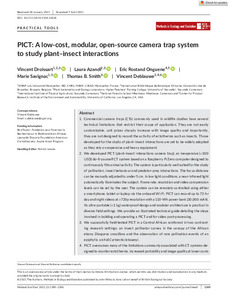| dc.contributor.author | Droissart, V. |
| dc.contributor.author | Azandi, L. |
| dc.contributor.author | Onguene, E.R. |
| dc.contributor.author | Savignac, M. |
| dc.contributor.author | Smith, T.B. |
| dc.contributor.author | Deblauwe, V. |
| dc.date.accessioned | 2022-09-23T08:42:55Z |
| dc.date.available | 2022-09-23T08:42:55Z |
| dc.date.issued | 2021 |
| dc.identifier.citation | Droissart, V., Azandi, L., Onguene, E.R., Savignac, M., Smith, T.B. & Deblauwe, V. (2021). PICT: A low‐cost, modular, open‐source camera trap system to study plant–insect interactions. Methods in Ecology and Evolution, 12(8), 1389-1396. |
| dc.identifier.issn | 2041-210X |
| dc.identifier.uri | https://hdl.handle.net/20.500.12478/7800 |
| dc.description.abstract | Commercial camera traps (CTs) commonly used in wildlife studies have several technical limitations that restrict their scope of application. They are not easily customizable, unit prices sharply increase with image quality and importantly, they are not designed to record the activity of ectotherms such as insects. Those developed for the study of plant–insect interactions are yet to be widely adopted as they rely on expensive and heavy equipment. We developed PICT (plant–insect interactions camera trap), an inexpensive (<100 USD) do-it-yourself CT system based on a Raspberry Pi Zero computer designed to continuously film animal activity. The system is particularly well suited for the study of pollination, insect behaviour and predator–prey interactions. The focus distance can be manually adjusted to under 5 cm. In low light conditions, a near-infrared light automatically illuminates the subject. Frame rate, resolution and video compression levels can be set by the user. The system can be remotely controlled using either a smartphone, tablet or laptop via the onboard Wi-Fi. PICT can record up to 72-hr day and night videos at >720p resolution with a 110-Wh power bank (30,000 mAh). Its ultra-portable (<1 kg) waterproof design and modular architecture is practical in diverse field settings. We provide an illustrated technical guide detailing the steps involved in building and operating a PICT and for video post-processing. We successfully field-tested PICT in a Central African rainforest in two contrasting research settings: an insect pollinator survey in the canopy of the African ebony Diospyros crassiflora and the observation of rare pollination events of an epiphytic orchid Cyrtorchis letouzeyi. PICT overcomes many of the limitations commonly associated with CT systems designed to monitor ectotherms. Increased portability and image quality at lower costs allow for large-scale deployment and the acquisition of novel insights into the reproductive biology of plants and their interactions with difficult to observe animals. |
| dc.description.sponsorship | Bob Taylor |
| dc.description.sponsorship | Leonardo DiCaprio Foundation |
| dc.description.sponsorship | American Orchid Society |
| dc.format.extent | 1389-1396 |
| dc.language.iso | en |
| dc.subject | Ecology |
| dc.subject | Video Recorders |
| dc.subject | Cameras |
| dc.subject | Technology |
| dc.subject | Pollination |
| dc.title | PICT: A low-cost, modular, open-source camera trap system to study plant–insect interactions |
| dc.type | Journal Article |
| cg.contributor.affiliation | Université Montpellier |
| cg.contributor.affiliation | Université Libre de Bruxelles |
| cg.contributor.affiliation | University of Yaoundé I |
| cg.contributor.affiliation | International Institute of Tropical Agriculture |
| cg.contributor.affiliation | National Forestry School Mbalmayo |
| cg.contributor.affiliation | University of California |
| cg.coverage.hub | Central Africa Hub |
| cg.researchtheme | Natural Resource Management |
| cg.identifier.bibtexciteid | DROISSART:2021 |
| cg.isijournal | ISI Journal |
| cg.authorship.types | CGIAR and developing country institute |
| cg.iitasubject | Food Security |
| cg.iitasubject | Pests of Plants |
| cg.journal | Methods in Ecology and Evolution |
| cg.notes | Open Access Article; Published online: 25 Apr 2021 |
| cg.accessibilitystatus | Open Access |
| cg.reviewstatus | Peer Review |
| cg.usagerightslicense | Creative Commons Attribution 4.0 (CC BY 0.0) |
| cg.targetaudience | Scientists |
| cg.identifier.doi | https://dx.doi.org/10.1111/2041-210X.13618 |
| cg.iitaauthor.identifier | Vincent Deblauwe: 0000-0001-9881-1052 |
| cg.futureupdate.required | No |
| cg.identifier.issue | 8 |
| cg.identifier.volume | 12 |
| cg.contributor.acknowledgements | This study is part of the Congo Basin Institute's Ebony Project generously funded by UCLA and Bob Taylor, owner of Taylor Guitars and co-owner of Crelicam ebony mill in Yaoundé, Cameroon. Field investigations and materials were partly funded by the Fondation pour Favoriser la Recherche sur la Biodiversité en Afrique (João Farminhão and Laura Azandi as PI), the Leonardo Dicaprio Foundation and the Aspire Grant Program (Laura Azandi as PI). We express our gratitude to the American Orchid Society (AOS) for funding the Ph.D. activities of Laura Azandi in Cameroon and her stay in the herbarium of
Université Libre de Bruxelles. We are grateful to David Roubik for the identification of D. crassiflora pollinators. We are much indebted to Fabienne Van Rossum and Camille Cornet for providing us with the video sequence on Silene nutans L. shown in Video S3. We are grateful to the conservator and staff of the Dja Faunal Reserve, local authorities and communities around the Reserve for their support and help during fieldwork activities. We also thank Ruksan Bose and two anonymous reviewers whose comments helped us to improve the quality of the final version of this manuscript. |

